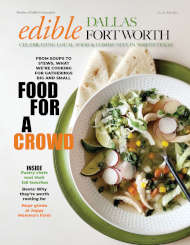By Cynthia Lathrop • Photographs by Jim Walker, Styling by Martha Dye-Walker
Beautiful soup so rich and green
Waiting in a hot tureen
Who for such dainties would not stoop?
Soup of the evening, beautiful soup.
—Sung by the mock turtle in Alice in Wonderland by Lewis Carroll
The pivotal soup.
My very first soup, when I was seriously beginning to cook, was Elizabeth David’s “Potage Bonne Femme”, an old-fashioned French housewife’s simple vegetable soup of potatoes, carrots, leeks, butter, water (as broth), and to finish, a little cream and snippet of parsley or chervil. This “good girl soup”, as it became known in the little café on Cornelia Street in New York City where I was first cooking, was the essence of HOME — comforting, healthy, chunky and brothy in the rustic style, or more elegant and velvety smooth with a spin in the food processor.
Many delicious soups spring from the classic potato-leek (or onion) base: ginger parsnip, butternut or other winter squash, “Celestine” with celery and celery root and an earthy cauliflower with chunks of roasted cauliflower as garnish. Chef/mentor Julie Finch created another variation of the classic French potato leek by crushing a handful of canned plum tomatoes into the broth. She named it “Fortuny”, after the soft salmon-pink-red color of a dress she once owned by that designer.
The many pleasures of cooking are expressed in the ritual of soup making, from softening the aromatic vegetables (onions, carrots, celery) in butter or olive oil until translucent to adding the earthy vegetables to pick up the base notes. Adding the broth and herbs for the gentle simmering is like watching a small tide pool. This is the beautiful alchemy where science and art and taste converge. Taste memory is one of the essential tools for recreating a recipe. My mother made big pots of nourishing soup for our large family: ham and navy bean, chicken and noodle, beef and barley and vegetable – all Midwestern basics. (Many of us remember that great taste combination of cream of tomato soup with grilled cheese sandwiches for Saturday lunch.) My mother always tossed a few bay leaves into her soups and years later in my culinary soup-making world this was referred to as “three bay leaves for Wilma”.
One can start a soup with just an idea in mind. I have a library of cookbooks that I use more as inspiration, reading them like a novel and as a reference to pull a meal together using different aspects of recipes. This is the creative part of cooking: thinking about what would taste delicious and maybe finding something wonderful tucked away in the pantry or refrigerator. Begin with a shopping list and a trip to your local farmers market in search of the freshest organic ingredients and you may be pleasantly surprised by the seasonal bounty, perhaps enough to change your menu. This is the “inspiration” talking. These small growers are the key to a sustainable and healthy future for all of us.
Making soup takes a bit of time, so just enjoy the trance-like state of preparing and sautéing the ingredients on low heat until the flavors begin to meld, adding stock and woody herbs like thyme and bay, letting everything simmer a while, and finishing with the delicate seasonings and tender greens (like spinach, basil, parsley) towards the end of cooking to retain their bright color and flavor.
The cooking tools are simplicity itself; a good heavy pot (I use an enameled cast iron casserole with lid that can go into the oven if a soup needs to braise on low heat for an hour or two) and a favorite wooden spoon for stirring. Add a strainer if using the food processor, though a friend has raved about a simple immersion blender that can whisk everything right in the pot (remove any bay leaves or bouquet garni stems first).
For serving, I’m a firm believer in the rustic soup-to-table presentation. Place the soup pot on a heavy cloth on the table so that the soup stays hot and ladle directly into the bowls from there and always pass a crusty loaf of bread for mopping up the broth. (It’s also nice to warm the bowls in the oven along with the bread.) To introduce your
soup and entice with a hint of the deliciousness to come, add a simple garnish that complements the flavors of the soup such as chopped fresh herbs, crunchy croutons, a drizzle of heavy cream or good olive oil or some grated cheese. You will create a visual pause, a moment to “ooh and ah” and savor the good smells, before your guests swirl their
spoon into the bowl.
“Beau—ootiful Soo-oop!”
Here are a few favorite recipes to get you started.
Asian-inspired Noodle Soup
Italian Ribollita
Potage Bonne Femme
Lentil Soup Martha’s Cornbread
Edible Dallas & Fort Worth is a quarterly local foods magazine that promotes the abundance of local foods in Dallas, Fort Worth and 34 North Texas counties. We celebrate the family farmers, wine makers, food artisans, chefs and other food-related businesses for their dedication to using the highest quality, fresh, seasonal foods and ingredients.











